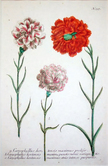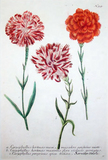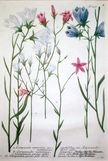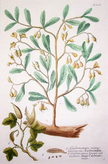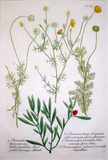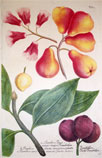
(Click images to enlarge and for purchase information.) Want to know more about prints? |
|||||||||||||||||||||||||||
Johann Weinmann was director of the oldest established pharmacy in the German town of Regensburg, legal captial of the Holy Roman Empire. He had amassed a vast collection of plants and desired to publish a descriptive and illustrated work about this collection. (Because all medicine was botanically derived,physicians and apothecaries were serious students of plants.Their published works developed the science of boany.) Weinmann was fortunate to make the acquaintance in Regensburg of Georg Dionysius Ehret, a gardener but also a surberb botnical artist. Ehret,was traveling through Regensburg after leaving the employ of Margrave Karl III Wilhem of Baden-Durlach. Weinmann saw some of Ehret's drawings and immediately engaged him to paint "1,000 figures of plants for 50 thaler a year." Ehret accepted , delighted to earn money from painting in place of the hard labour of gardening. This was the beginning for Ehret of a new career which would eventually bring, not only money and prestige, but a reputation as the finest botanical artist of the 18th century. Ehret completed 500 paintings in the first year of Weinmann's work, about one and one-half paintings a day. Weinmann, however paid Ehret less than half the agreed on amount, arguing that he provided free room and board. Ehret disappointed by Weinmann's parsimony deceided to move on. Weinmann engaged other artists to finish his geat work. Each of the completed 1,000 plates is a color-printed mezzotint, finished by hand. (see my Glossary in "Want to Know More about Prints") The finished work, Phytanthoza Iconographia (1737-45), taking over eight years to complete and comprising eight folio volumes describes and illustrates several thousand plants.
|
|||||||||||||||||||||||||||


